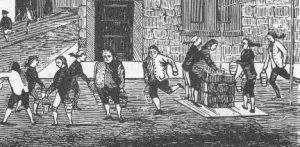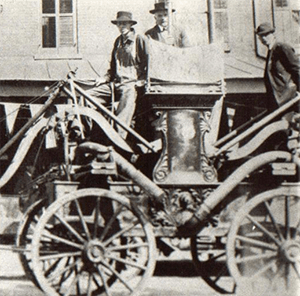And the Evolution of Fire Protection Engineering
We’re all about fire hose here at Rawhide, but have you ever wondered what their history is? Learning about how we went from ox gut to the powerhouse double jacket attack hose is essential to understanding fire protection engineering and garners an appreciation for the inventors of the ages and those who risked their lives fighting the fires to keep us safe.
The First Bucket Brigade
It seems that as soon as man created fire, he just as quickly discovered how to put it out. Well before a conduit was invented, man literally carried water to fires by hand. This led to the realization that if a vessel could carry a lot of water, the fire would be extinguished faster. Thus, bags made from ox gut were born, and their existence was documented as early as 400 B.C., in which the bags were filled, then stomped on, blasting the water out of the bag and onto the fire.
The Invention of the First Fire Hose
Who invented the first fire hose?
Around 1673, Dutch painter, inventor and printmaker, Jan van der Heyden and his son produced what they referred to as “fire hose”. Jan van der Heyden went on to write the first firefighting manual: Brandspuiten-boek.
What material was used for the first fire hose?
Interestingly, Jan van Heyden and his son sewed leather tubes together. Leather is known to be tough, yet flexible making for a good way to carry that water to the fire. Leather is also known as ……Rawhide.
The first hoses were sewn in 50-foot lengths, which is still considered a standard length to this day. This allowed firefighters to get closer to the fire, which enabled them to aim and shoot the stream precisely where they wanted it.
The Introduction of Fire Hydrants
In the early 1800’s, fire protection engineers introduced hydrants, tanks and cisterns and nozzles were designed to further improve water flow characteristics. One problem that surfaced early on and plagued early fire hoses was leakage. The stitches that connected the leather leaked and after a while the leather itself began to seep water. The introduction of pump action tankers led to overpressure in which the hose would burst.
Rivets were introduced in 1807 and were applied to the thickest part or rear quarters of the cowhides. This made the hose almost leakproof, however, it added significant weight. A 40 to 50 foot length of hose weighed upwards of 85 pounds. The leather hose required a good deal of maintenance much as it still does today. Early leather hose was treated with fish and whale oil to help preserve it.
Improved Fire Hoses
In 1821, James Boyd patented rubber lined, woven jacketed fire hose. In those early days of modern fire hose the jackets were made from spun cotton. Akron Ohio’s own Charles Goodyear discovered the vulcanization process and applied that to rubber hose, reinforced with cotton ply.
Through the subsequent decades to follow, the fire hose has undergone monumental changes. The jackets are now polyester woven yarn, treated to resist mold, mildew and abrasion. One can only wonder, what improvements and developments lie ahead.



